Science
Solar Energy Tracker Powers Down After 17 Years

The Sun is Earth’s primary power source. Energy from the Sun, called solar irradiance, drives Earth’s climate, temperature, weather, atmospheric chemistry, ocean cycles, energy balance and more.
- Read more
- 316 reads
Iron is everywhere in Earth's vicinity, suggest two decades of cluster data.

Iron in the solar wind and Earth's magnetosphere.
- Read more
- 371 reads
The Strange Orbits of ‘Tatooine’ Planetary Disks

Two examples of aligned and misaligned protoplanetary disks around binary stars (circumbinary disks), observed with ALMA. Binary star orbits are added for clarity. Left: in star system HD 98800 B, the disk is misaligned with inner binary stars. The stars are orbiting each other (in this view, towards and away from us) in 315 days. Right: in star system AK Sco, the disk is in line with the orbit of its binary stars. The stars are orbiting each other in 13.6 days.
- Read more
- 302 reads
Chandra Data Tests "Theory of Everything"

X-ray Images of Perseus Cluster
Astronomers used Chandra to look for extraordinarily low-mass "axion-like" particles in the Perseus galaxy cluster. A Chandra observation lasting over five days of the central supermassive black hole in the center of the cluster showed no evidence for certain axion-like particles, which some theorists think can explain dark matter. The lack of a detection in these Chandra observations helps rule out some versions of string theory, a set of models intended to tie together all known forces, interactions, and particles.
- Read more
- 328 reads
Quasar Tsunamis Rip Across Galaxies

QUASAR OUTFLOWS ILLUSTRATION
- Read more
- 311 reads
Black Hole Team Discovers Path to Razor-Sharp Black Hole Images

Black Hole Team Discovers Path to Razor-Sharp Black Hole Images
- Read more
- 310 reads
GRACE, GRACE-FO Satellite Data Track Ice Loss at the Poles

Greenland's Steenstrup Glacier, with the midmorning sun glinting off the Denmark Strait in the background. The image was taken during a NASA IceBridge airborne survey of the region in 2016.
- Read more
- 294 reads
A Star-Bursting Galaxy Born from the Collision of Dwarfs

This 2.5 x 2.5 arcminute image shows VCC 848, a compact dwarf galaxy that scientists think formed from the merger of two smaller galaxies.
- Read more
- 299 reads
A New Theory of Magnetar Formation for Neutron Stars

Figure 1: 3D snapshots of the magnetic field lines in the convective zone inside a newborn neutron star. Inward (outward) flows are represented by the blue (red) surfaces. Left: strong field dynamo discovered for fast rotation periods of a few milliseconds, where the dipole component reaches 1015 G. Right: for slower rotation, the magnetic field is up to ten times weaker.
- Read more
- 314 reads
Continued Gravitational-Wave Discoveries from Public Data

Numerical-relativity simulation of the first binary black-hole merger observed by the Advanced LIGO detector on September 14, 2015.
- Read more
- 316 reads
Human Rights
Fostering a More Humane World: The 28th Eurasian Economic Summi

Conscience, Hope, and Action: Keys to Global Peace and Sustainability

Ringing FOWPAL’s Peace Bell for the World:Nobel Peace Prize Laureates’ Visions and Actions

Protecting the World’s Cultural Diversity for a Sustainable Future

Puppet Show I International Friendship Day 2020

